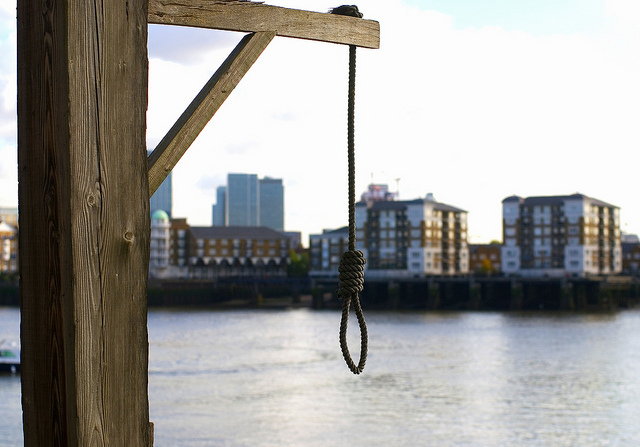Back in February, we took a look at London's courthouses – those redoubtable theatres in which the wheels of justice are set in motion. This time, we're inspiring you to visit some of the sites where London's justice has been doled out, often all-too cruelly. Don't worry though – there's plenty of food, booze, and even some gardens, along the way.
Prisons (and ex-prisons)
A visit to chokey doesn't usually constitute the ideal weekend jaunt. But there are plenty of exceptions here in London. The Clink, near to London Bridge, might be a bit of a tourist magnet, but there's no denying its significance in London's justice system. Felons were first banged up on this spot in 1144. Today, you can grimace at the horrific instruments of torture many would have been abused with.
Another Clink opened up recently – this one a restaurant in Brixton. Going by reviews, the food – made and served by HMP Brixton inmates – is decent, plus mobile phones are confiscated at the door (a bonus). More prison-based-yet-positive experiences can be enjoyed at the annual Open Garden Squares Weekend. This summer, Holloway, Wormwood Scrubs and Wandsworth prisons will be showing off their blooms, herbs and veggies to the public.
In this section, we couldn't forego mentioning the Tower of London, which has incarcerated everyone from William Wallace to the Krays (not to mention cage-loads of unfortunate animals). And although Newgate Prison is long-gone, you can still see the dreaded Execution Bell in St Sepulchre-without-Newgate.
Pubs
Nab a window seat at The Prospect of Whitby pub in Wapping, and you'll soon be aware of the unsettling sight of a noose swinging outside. Don't worry – it's not for customers who can't foot the tab – rather a brazen reminder of what this stretch of the Thames used to be, namely Execution Dock (read more about it here).

The last woman to be hanged for murder in Britain was Ruth Ellis, at Holloway prison in 1955. You can supposedly find evidence of her crime at the Magdela pub in Hampstead. This is where the platinum blonde call girl shot her lover David Blakely to death. The front of the The Magdela is peppered with marks that look like bullet holes (Ellis had fired many times, and even struck a bystander in the thumb.) The pub claims the holes are from the shooting, although others say they're from a plaque – since removed – which marked the site of Blakely's death.
Today, beer festivals and wedding receptions are the bread and butter of Le Gothique in Wandsworth. But this Hogwartsesque complex has switched roles many times; it's been an orphanage, a hospital, and a school. Most interesting to us, it served as a detention and interrogation centre during the Second World War – one of its cells housing the Nazi Rudolph Hess for a while.
Museums and miscellaneous punishment sites
London's police museums provide an all-round picture of crime and justice in the city. Of course, it's the latter we're concerned with here. At the City of London Police Museum, keep your eyes peeled for the heavy wooden truncheons that Victorian policemen would use to keep the city's ne'er-do-wells in check. More truncheons, plus handcuffs, nooses, and an escapee board can be found inside the minuscule Wandsworth Prison Museum. Cuffs (again), plus a fascinating 'punishment book' (dated 1839-1865) are among objects at the Thames Police Museum (this one's appointment only). Sadly, the notorious 'Black Museum', which contains such treasures as the Jack the Ripper 'From Hell' letter and Dennis Nilsen's cooking pot, is not open to the public.

The most infamous spot in London for public hangings was the Tyburn Tree. Countless criminals and martyrs gasped their dying breath swinging from the multiple-noose gallows, which stood near the southern tip of Edgware Road, until 1783. A cracked plaque marks the spot now. Recently, the Tyburn Tree inspired Marc Almond and John Harle to record a brooding album of the same name. Put it on the headphones during your visit, for added gloomy ambiance. Kennington Common was South London's answer to Tyburn. For a period of roughly 75 years, this green space doubled up as a venue for both hangings and cricket matches.
For more notable punishment and execution sites try: the Mount Pleasant Mail Centre (once home to the 20 evil treadwheels of Coldbath Fields Prison); Banqueting House (where you can retrace the final steps of Charles I before his beheading in 1649); and outside the Royal Exchange in Cornhill, near the conduit in Cheapside, and in Fleet Street near where Temple Bar originally stood. Daniel Defoe spent a day pilloried in each of these three spots in July 1703. As a happy coda to this article, Defoe had only flowers thrown at him, while his friends sold spectators copies of his specially-written text, A Hymn to the Pillory.
Thanks to Dick Bulch and Martyn for use of their images via the Londonist Fickr pool.
See also: A map of London's execution sites.




